Installation Contemporary
Designed to exhibit large-scale artworks in a diverse range of media, including moving-image, or more ambitious and conceptually driven projects that extend beyond the traditional booth presentation, Installation Contemporary presents an opportunity to view innovative, site-specific and interactive installations in the environment of Carriageworks.
The 2023 program presented large-scale artworks by 13 leading contemporary artists, curated by Sarah Hetherington.
Hetherington states: “Installation Contemporary offers artists the opportunity to push the boundaries of their practice and exhibit ambitious, museum-quality projects in the iconic architectural environment of Carriageworks. Collectively, the works explore themes of the body (human or animal), spirituality and transcendence, colonial history, language and cultural identity, memory and time, as well as materiality and the use of technology. Featuring Indigenous, Australian and International artists, Installation Contemporary, provides audiences with unexpected encounters and moments of reflection, surprise and hopefully enjoyment!”
Browse the 2023 Installation Contemporary Program below. Installation Contemporary 2024 coming soon.
Abdul-Rahman Abdullah
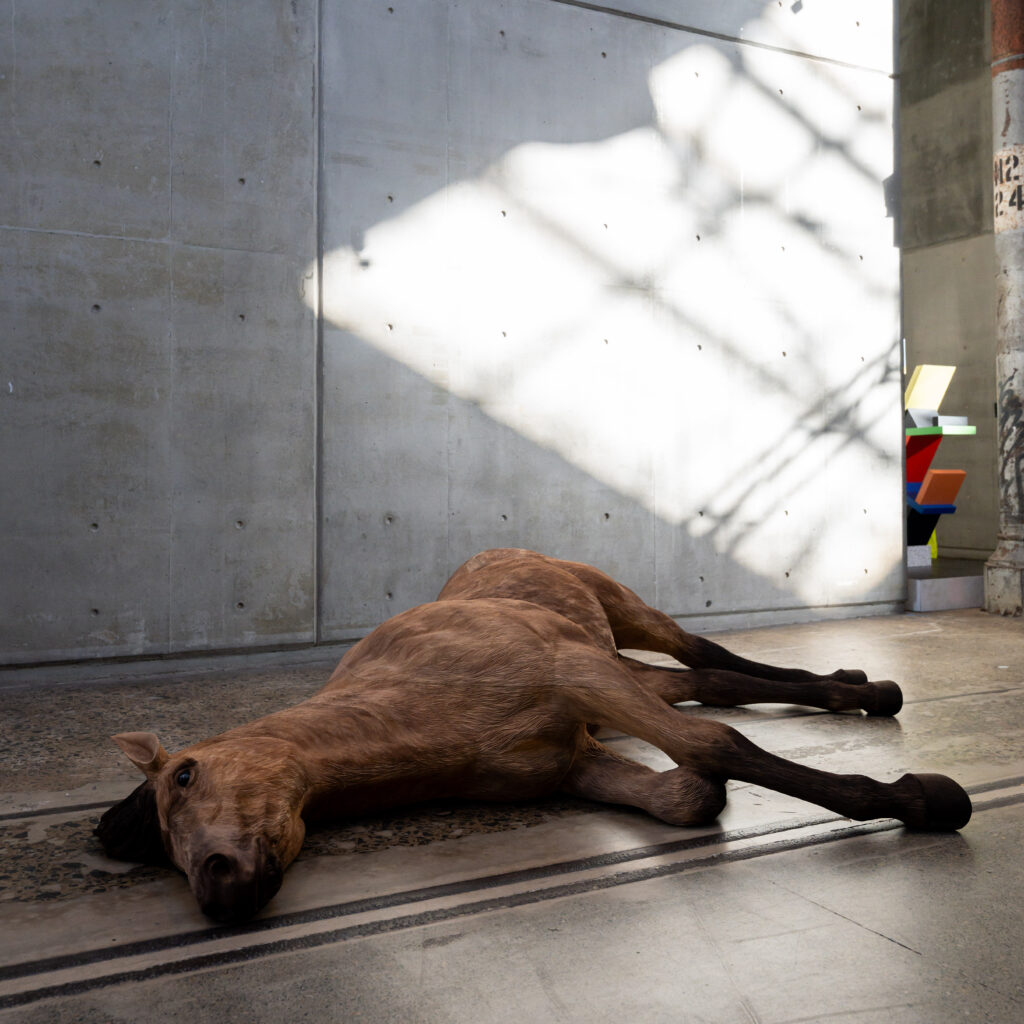
Dead Horse, 2022
Carved and stained wood
60 x 216 x 290 cm
Presented by Moore Contemporary
A sculpture that is singular in its representation yet abundant in its evocations. Abdul-Rahman Abdullah’s intent is to create a poetic encounter with a dead horse that is still life and allegory. There are many aspects attached to the horse as a cultural phenomenon. A history of heroes and anti-heroes in the defining of territory, farming of the land, the forging of national identities – whether fictional or not – and of contested ownership. Equine art and military art are steeped in narrative traditions of veneration, trophy and privilege. Dead Horse is a sculpture that is resonant paradoxically with presence and loss, with peace and pathos.
Abdul-Rahman Abdullah (b. 1977) is an Australian artist whose practice explores the different ways that memory can inhabit and emerge from familial spaces.
Alex Seton
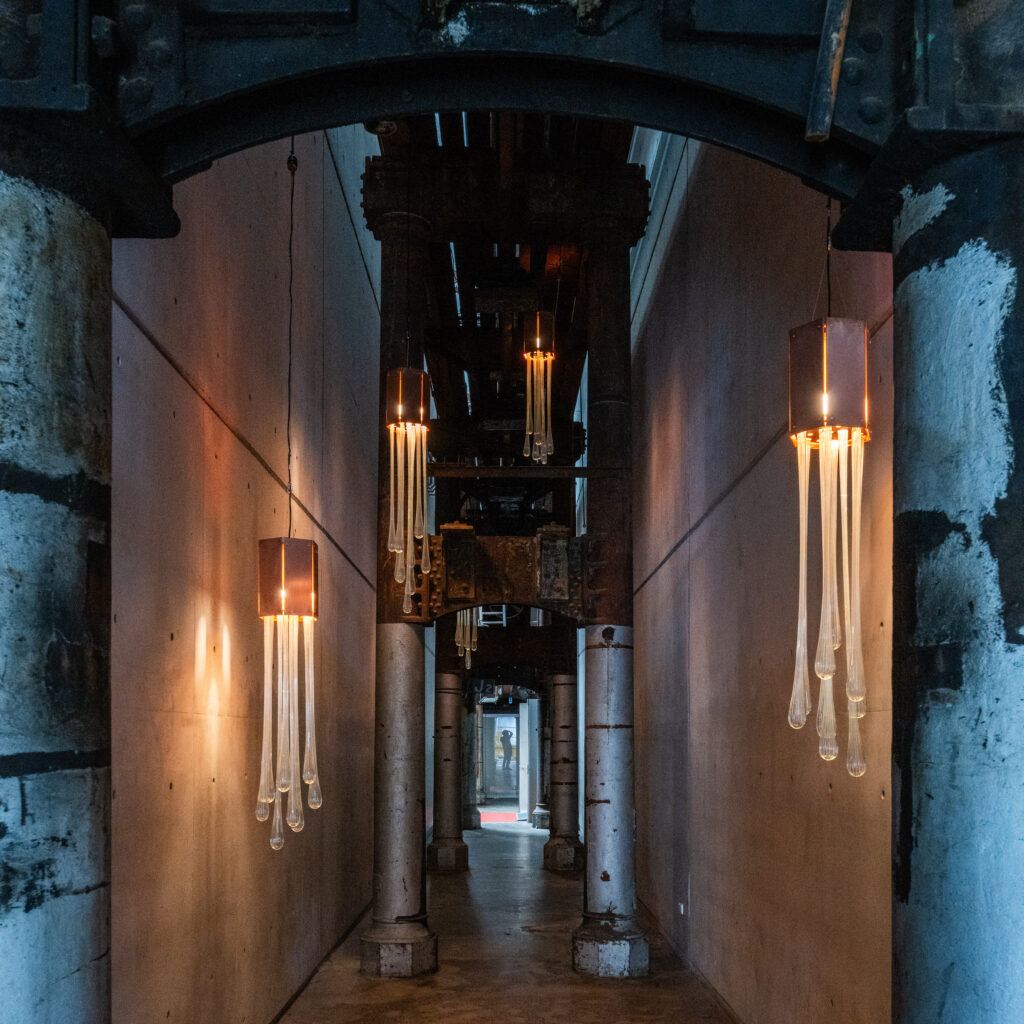
Trying to Reinvent Themselves and Their Universe, 2022
Soda glass, copper and brass, 1600lm LEDs
155 x 30 x 30 cm each
Presented by Sullivan+Strumpf
Created for the cells of The Lock-Up, Newcastle, Alex Seton presented a series of chandeliers in his recent exhibition Everything was Beautiful and Nothing Hurt (2022) in tribute to those made by Newcastle’s discontinued Leonora Glassworks. For Installation Contemporary, Trying to Reinvent Themselves and Their Universe, 2022 inhabits the contrasting environment of Carriageworks, further exploring themes of memory, forgetting and loss with the passing of time. The works riff upon chandeliers that were ubiquitous in the entranceways of clubs and RSLs of post- World War II Australia. The title of the exhibition refers to Kurt Vonnegut’s singular anti-war novel about the fire-bombing of Dresden that dislocates linear time. The founders of the Leonora glassworks started out making aircraft bomb-sights but flourished when they moved into art glass. Glass exists in its own special state of matter. It is a solid produced by cooling molten material that still holds its liquid memory. Seton contrasts the layered geological time evident in his favoured material of marble with this captive moment in glass.
Alex Seton (b. 1977) is an Australian artist whose practice incorporates marble sculpture, photography, video and installation to examine problematic ideas and concepts.
Brian Robinson
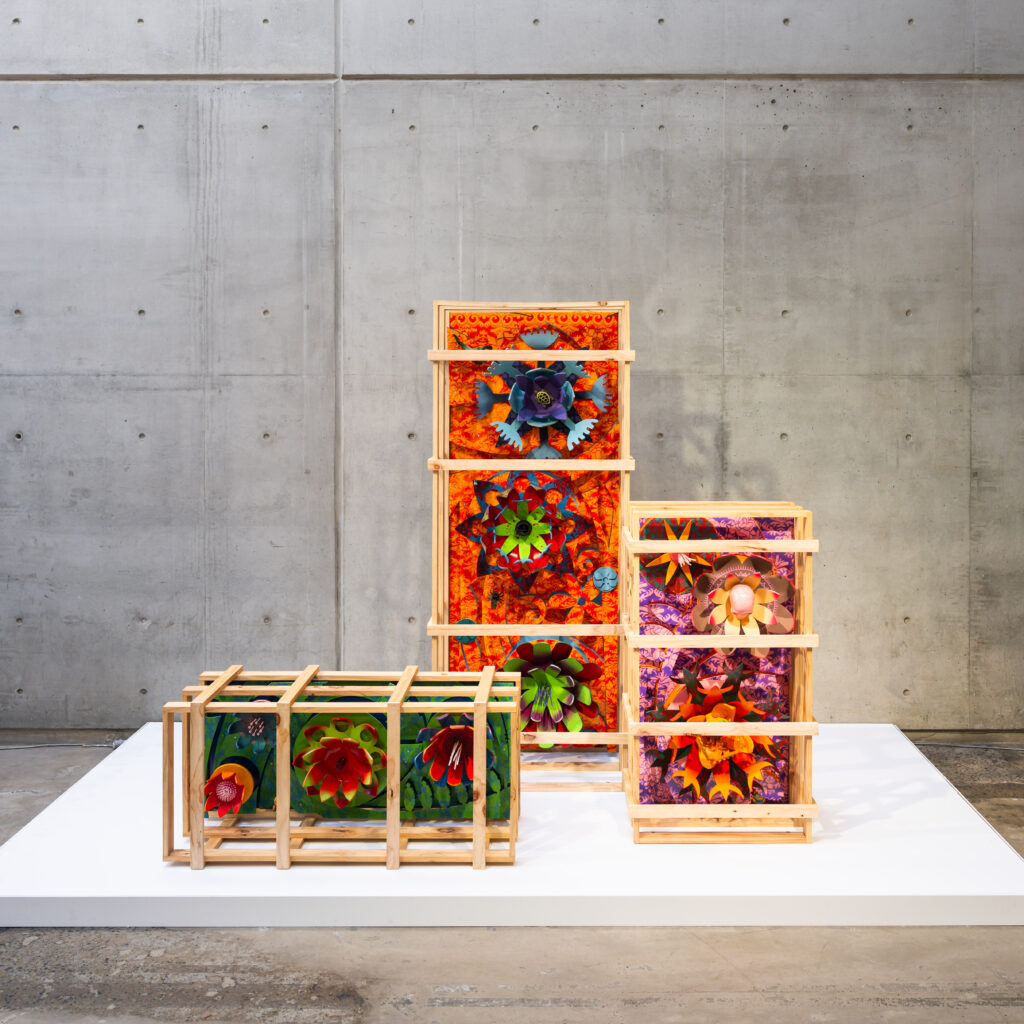
Banks Bounty: Exotic Cargo, 2022
Palight plastic, wood, enamel spray paint, found objects, toys
3 pieces: 205 x 85 x 60 cm, 60 x 125 x 55 cm, 125 x 60 x 40 cm
Presented by Mossenson Galleries
Over 250 years ago naturalist Joseph Banks sailed to the Pacific with James Cook aboard HMB Endeavour. During the voyage, Banks made the first scientific collections of Australian Flora, which were crated up and taken back to England to be studied, dissected, and drawn in the name of botanical science. Little did they realise that these exotic species had been used for food and medicinal purposes for thousands of years by Aboriginal and Torres Strait Islander people, the traditional custodians of the country. Banks, Daniel Solander, and their assistants made specimens of 132 plant species in six days at Botany Bay. After leaving Botany Bay, they spent seven or so days collecting specimens at other landings along the coast. On 11 June 1770, calamitously, Endeavour struck the Great Barrier Reef. The disaster allowed for seven weeks of exploration and collecting on Guugu Yimidhirr country while the ship was repaired on the banks of Waalumbaal Birri, the Endeavour River.
Brian Robinson (b. 1973) is a Maluylgal and Wuthathi man known for his printmaking and public sculptures in which he uses a variety of techniques to produce bold, innovative and distinctive works.
Jenna Lee
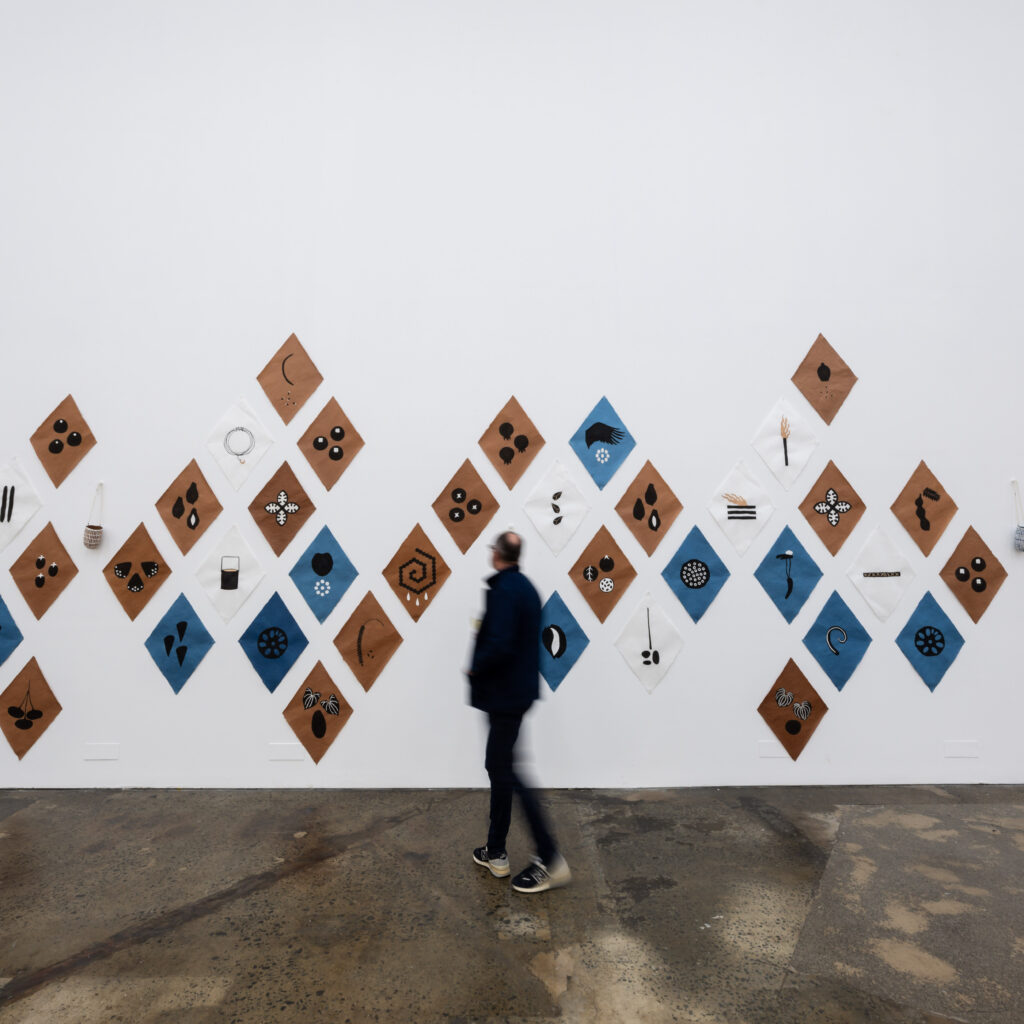
to gather, to nourish, to sustain, 2022–23
Awagami custom haruki-shi diamond persimmon dyed, Awagami custom haruki-shi diamond indigo dyed, Awagami custom haruki-shi diamond white, sumi, Gulumerridjin garramal-wa (Larrakia white ochre), Nikawa, bookbinding linen
Dimensions variable
Presented by MARS Gallery
to gather, to nourish, to sustain, first shown as a part of TarraWarra Biennial 2023: ua usiusi faʻavaʻasavili curated by Dr Leuili Eshragi, imagines how words relating to the daily gathering of nourishment can be translated into an iconographic language. Symbols are displayed in a bespoke grid system inspired by the traditional mark making of the artist’s people. This work sees over 45 individual words translated and hung in a flexible, site specific installation, demonstrating the ecological and lexical abundance of traditional lands, foods and words. This work focuses on paper Dilly-bags as the physical objects used in acts of gathering – but to gather, to nourish, to sustain surrounds these objects with extensive context. The space becomes fruitful with words relating to their use, their materiality, and their purpose, returning context to the objects within our ecology.
Jenna Lee (b. 1992) is a Gulumerridjin (Larrakia), Wardaman and KarraJarri Saltwater woman with mixed Japanese, Chinese, Filipino and Anglo-Australian ancestry, using art to explore and celebrate her many overlapping identities.
Jon Rafman
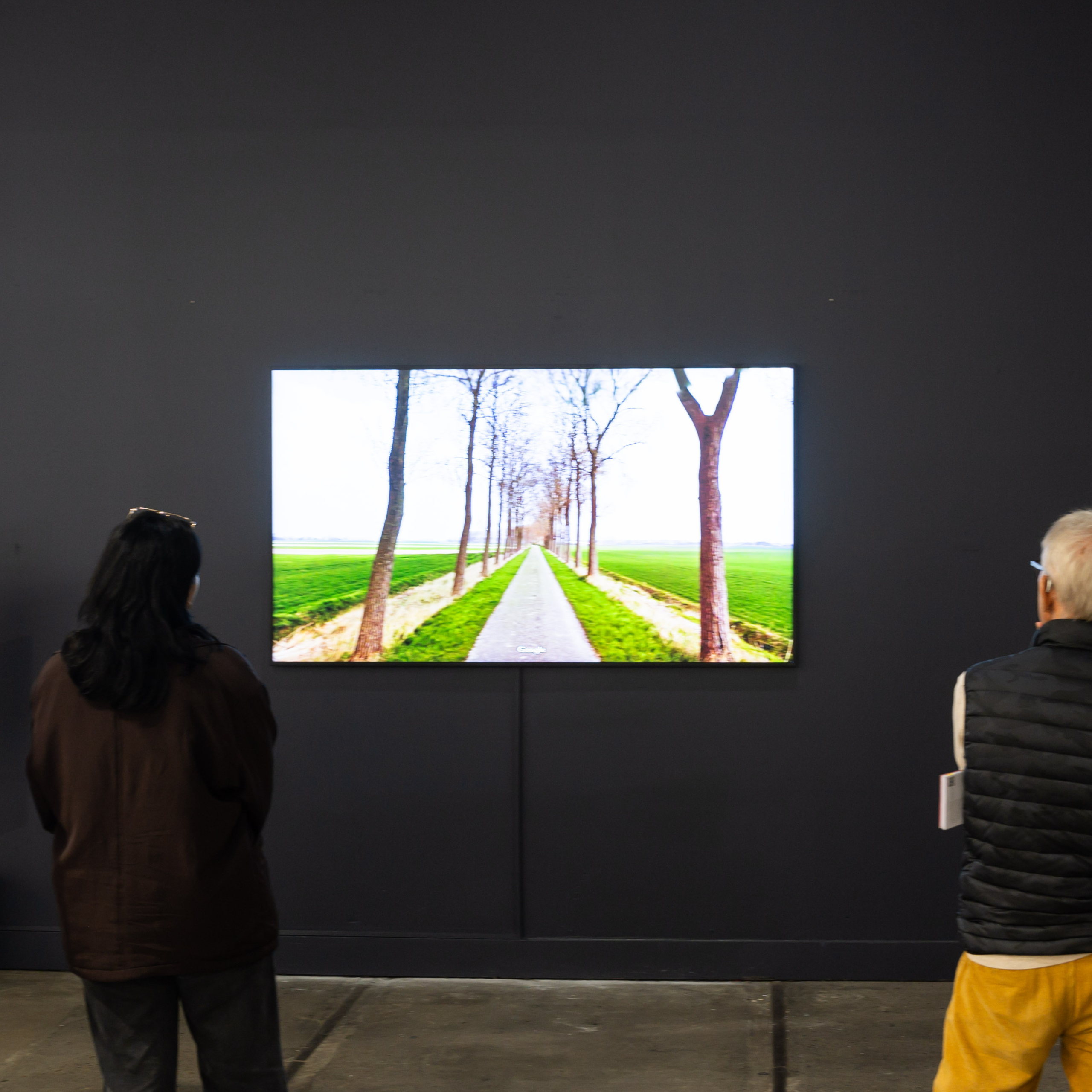
Nine Eyes of Google Street View (slideshow), 2008–2020
4K video, sound
65 Minutes
Presented by Neon Parc
Jon Rafman presents an iteration of his ongoing major project Nine Eyes of Google Street View, 2008–present, displaying a fascinating array of incidental moments reframed from Google Street View, compiled over a decade of research. Rafman reintroduces the human gaze and reasserts the importance of the individual, whilst highlighting the tension between indiscriminate automated capture and the human desire for meaning characteristic of contemporary existence.
Jon Rafman (b. 1981) is acclaimed for a multifaceted oeuvre encompassing video, animation, photography, sculpture, and installation.
Julie Rrap
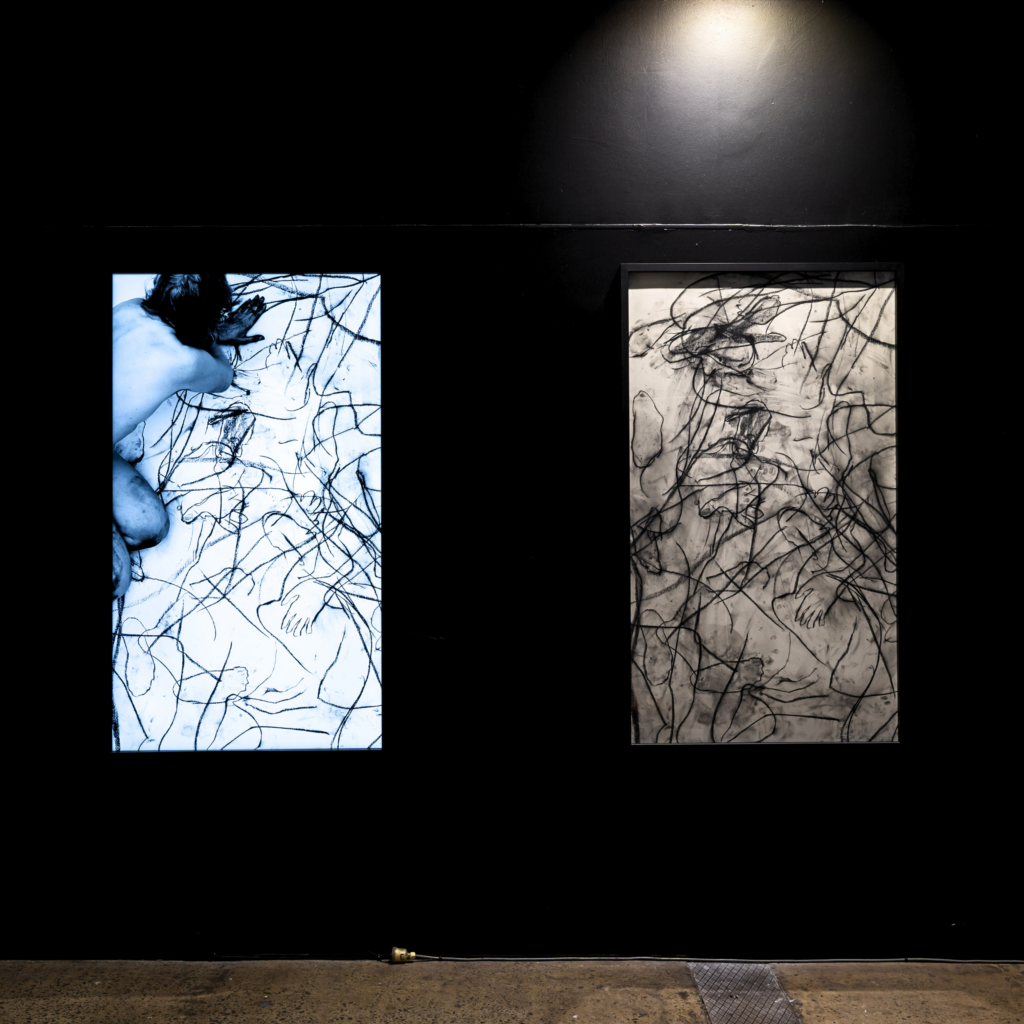
The Dust of History (Framed), 2022
Charcoal pastel on watercolour paper; single channel video with sound
159 x 93cm (framed); approx. 9 minute video
Presented by Roslyn Oxley9 Gallery
In this mixed media installation, video recordings show the artist – shot from above – in the act of rubbing, smudging and smearing charcoal on large sheets of watercolour paper. Julie Rrap has been a major figure in Australian contemporary art for over forty years. Since the mid-1970s, she has worked with photography, painting, sculpture, performance and video in an on-going project concerned with representations of the body.
Julie Rrap (b. 1950) challenges, subverts and reinterprets the definition of women and their image in surprising ways.
Lindy Lee
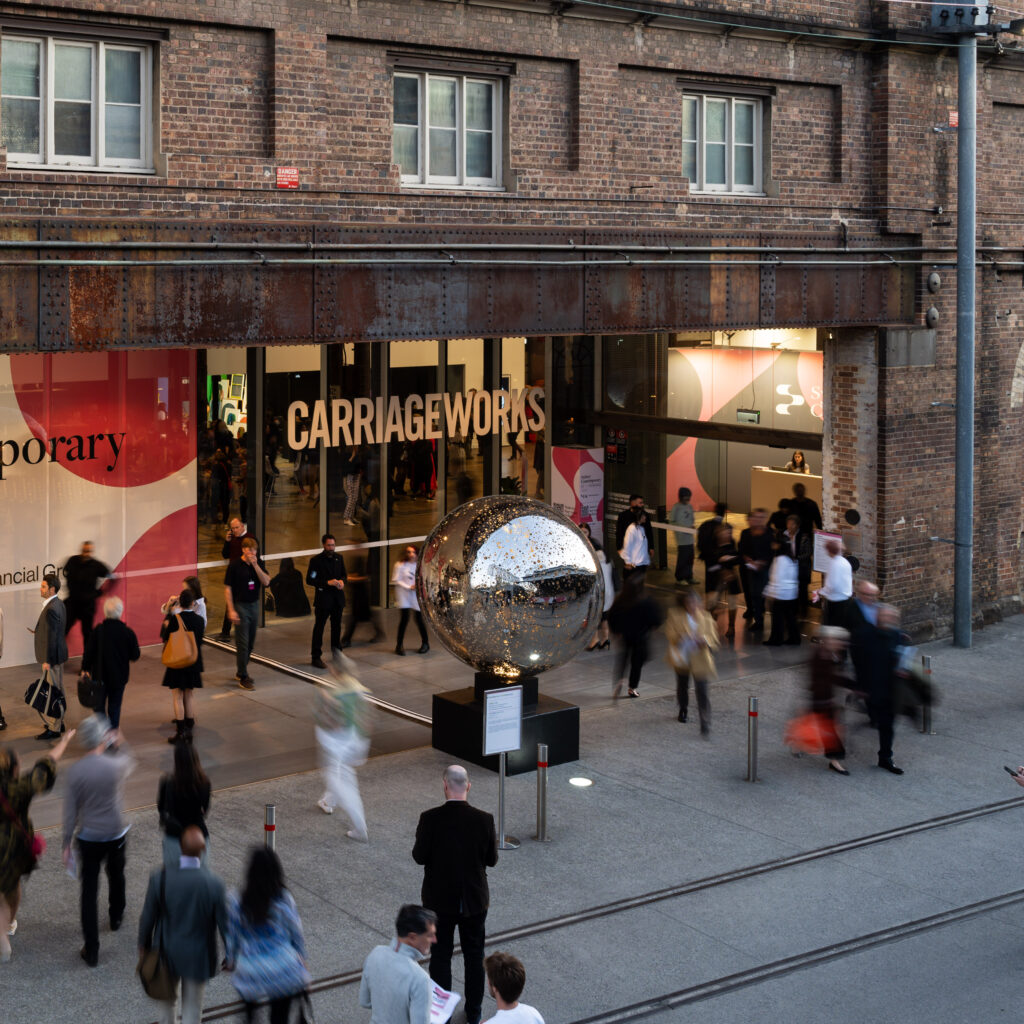
One Bright Pearl, 2021
Mirror polished 316 stainless steel
200 cm diameter
Presented by by Sullivan+Strumpf
One Bright Pearl is inspired by the ancient Chinese story of the Dragon’s Ball, which is a symbol of universal wholeness, well-being, wisdom, and spiritual power. During the day, the sculpture’s surface, with its mirror brightness, absorbs and reflects the fleeting and ever-changing pageantry of the surrounding world: the movements of people, sky, landscape, birds. At night, the work will be internally lit to allow light to flow back out into the world.
Lindy Lee’s (b. 1954) practice explores her Chinese ancestry through Taoism and Ch’an (Zen) Buddhism.
Louise Zhang
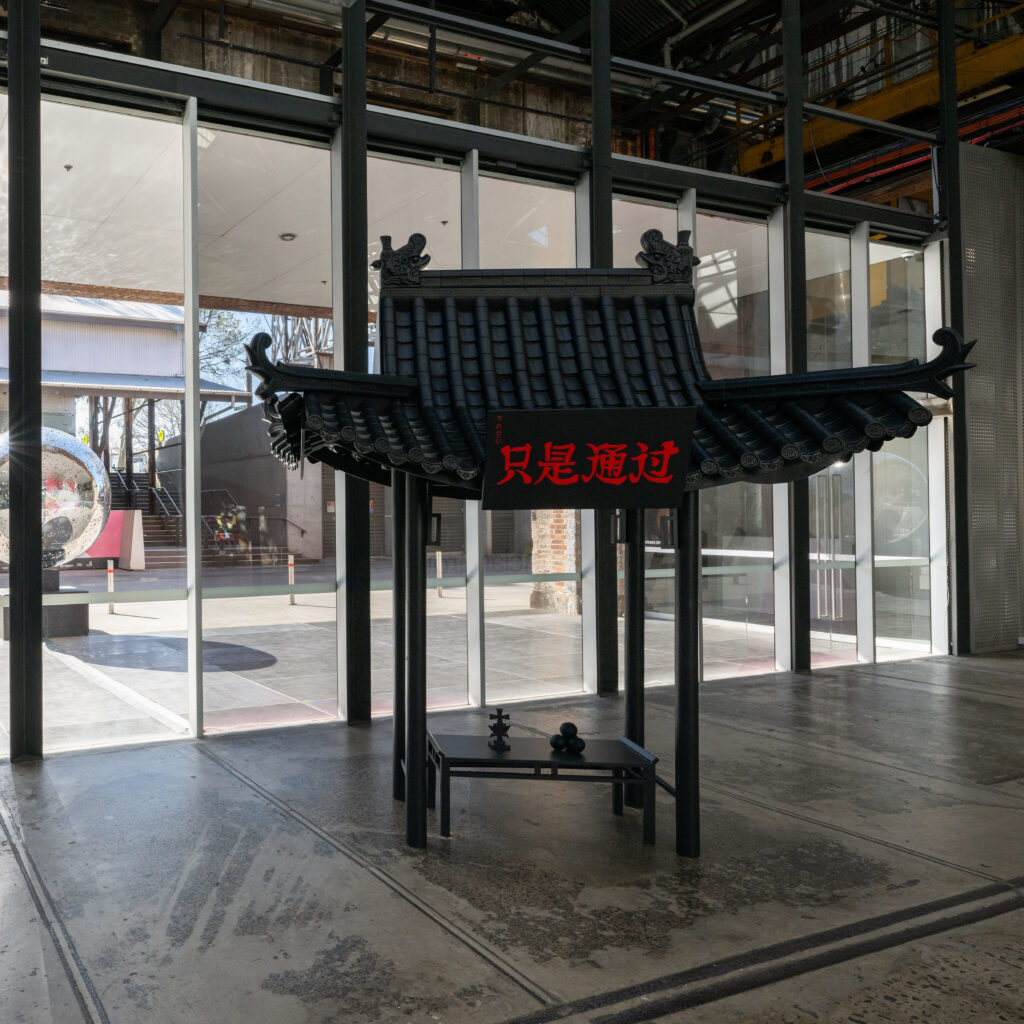
Temple, 2023
Moulded plastic, resin and timber
315 x 290 x 212 cm
Presented by N.Smith Gallery
Temple is an architectural installation modelled from the Zhang family temple on Qidu, an island located within Wenzhou, China. It stands as a ghost, silhouetted in gothic black paint. Temple’s shape is a haunting spectre, built from the artist’s memory and candid photo references from her family members in China. Zhang, herself, has never entered the actual building, forbidden by her Christian-abiding parents as antithetical to their faith. Through its recreation in the gallery, the artist attempts to rebuild what has been lost – a missing link between Zhang and her ancestors.
Louise Zhang 张露茜 (b. 1991) is a Chinese-Australian multidisciplinary artist whose practice explores the dynamics of aesthetics.
Nabilah Nordin
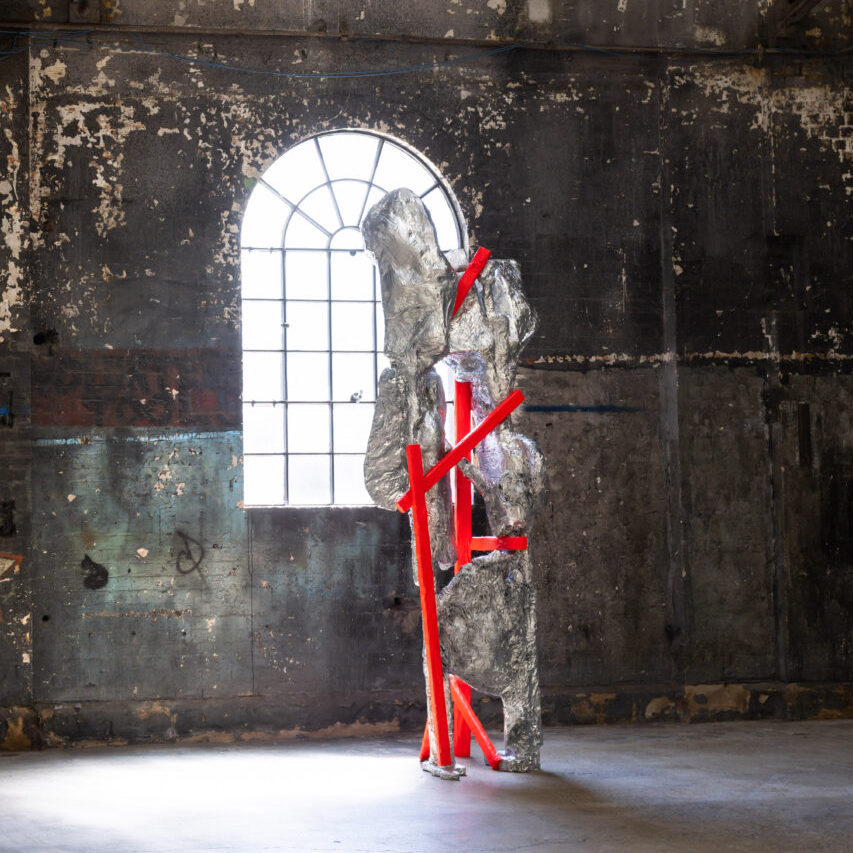
Molten Slayer, 2022
Wood, foam, canvas, epoxy modelling compound, spray paint
339 x 129 x 96 cm
Presented by Neon Parc
Working improvisationally at a monumental scale, Molten Slayer challenges and expands the possibilities of formal abstraction, while gently referencing the heavy weight of classical figurative sculpture. The work is a collision of old and new, a voyage through multiple sculptural histories. The main body of the sculpture mashes together 20th century modernist and brutalist architecture with clumpy, bodily shapes referential of classical Roman statues. The weight of these histories are held up and supported by a haphazard, bright orange neon scaffolding. They are like hazard lights signalling an imminent threat of collapse. Molten Slayer speaks to Nabilah Nordin’s constantly expanding sculptural vocabulary, where the makeshift meets with the monumental.
Nabilah Nordin completed a Master of Contemporary Art at Victorian College of the Arts in 2015, and a Bachelor of Fine Arts at RMIT University in 2013.
Roy Wiggan
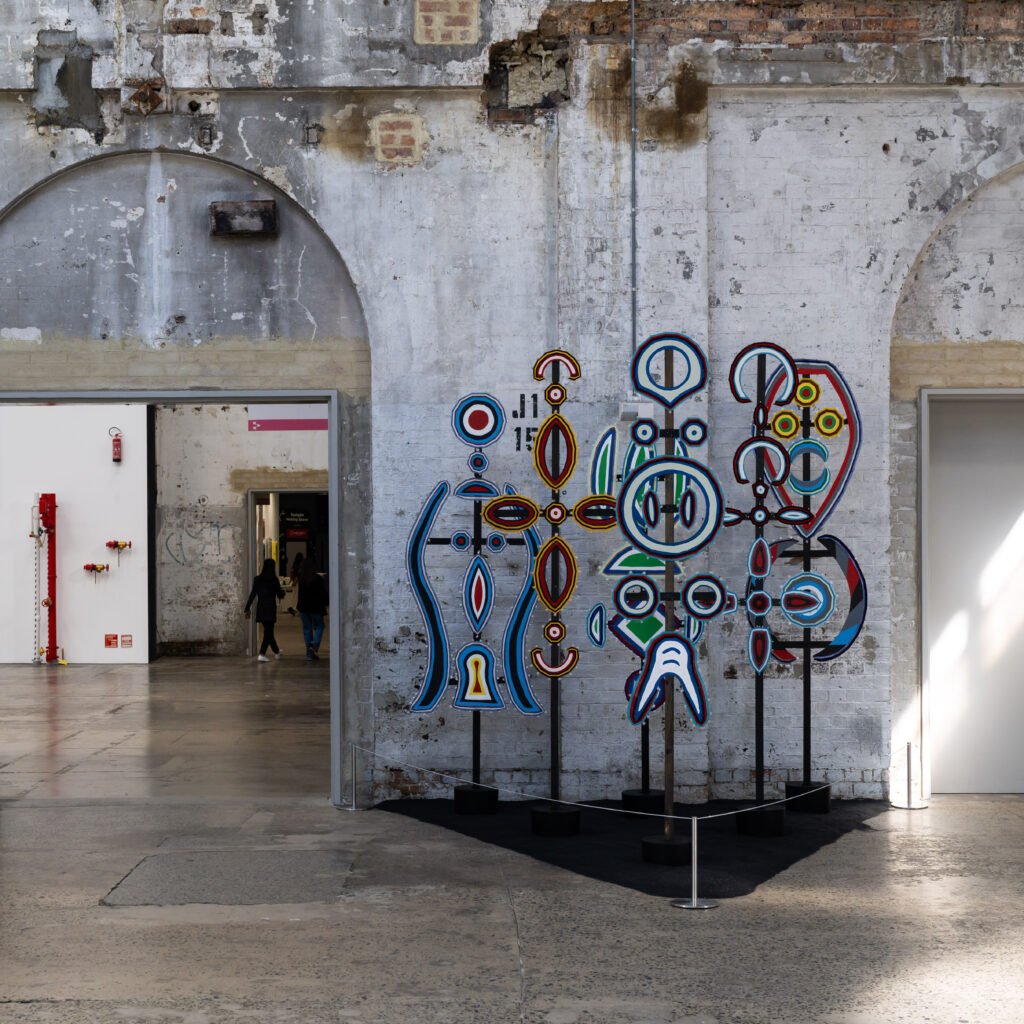
Ilma, 2002
Painted plywood, nails, thread and cotton
Heights variable
Presented by A Secondary Eye
Roy Wiggan’s ilma are striking representations of his intimate knowledge of the coastal areas and tidal patterns of his country near the Dampier Peninsula in North West Australia. Whilst passing in 2015, his importance as an artist remains and his artworks act as an ongoing reference of Bardi cultural knowledge and storytelling. The ilma are hand-held objects made from timber, steel, acrylic paint and cotton. Wiggan’s ilma can depict physical objects or natural phenomena such as tides and rain, or embody more metaphysical concepts. Many of the stories are inspired by the Bardi’s unique relationship with their country, and indeed with the sea, as they are a seafaring people with an intimate knowledge of tidal patterns and marine life.
Roy Wiggan (1930 – 2015) was a senior Bardi elder who was the custodian of many traditional stories and songs relating to the land and sea in the country near the Dampier Peninsula in North West Australia.
Sam Jinks
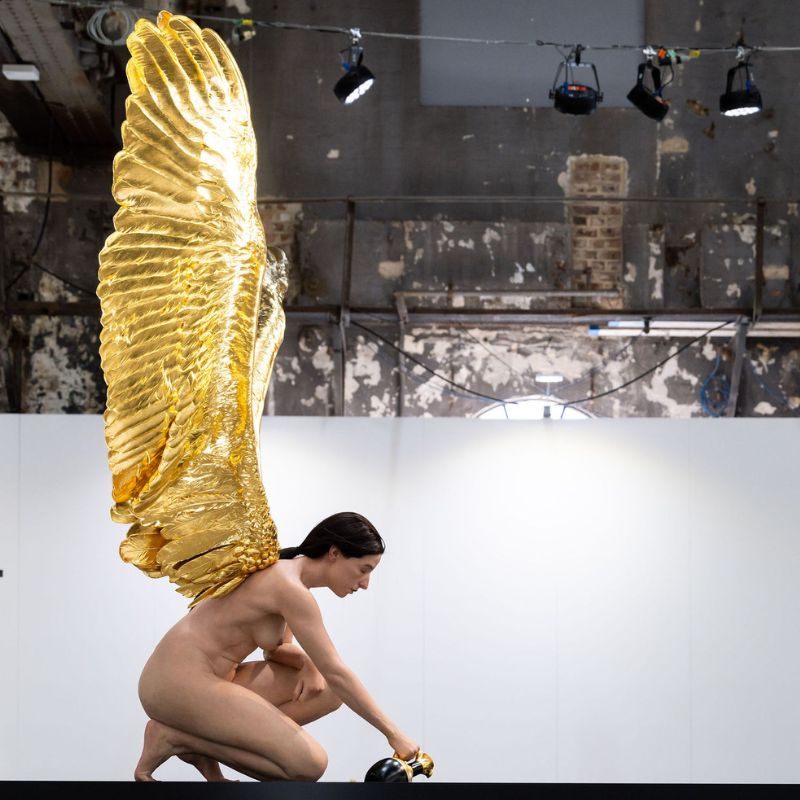
Iris – the messenger, 2018
24k gold (wings), silicone, pigment, hair, water
270 x 230 x 500 cm
Presented by Sullivan+Strumpf
Iris – The Messenger in Greek mythology was the messenger of the gods and the personification of the rainbow. The hyperrealistic figure of the woman scooping water from the pitch-black reflective pool invites one in closer, while the enormity of her golden wings require one to step backwards to fully appreciate the work. The ancient goddess represents our prevailing need for human connection, as humans always have. The golden, shimmering wings gleam in the reflection below. Jinks originally wanted a lot of gold for the wings, but that would have involved electroplating them. “It was unrealistic because of the size, each wing is about two metres. There was nowhere in Australia and potentially, in the world outside of somewhere like NASA that could execute something like that,” Jinks said when he was creating the first edition of this work. The eventual alternative was to finish the wings in gold leaf, achieving the ethereal quality and beautifully mixing the godlike with the inherent humanness of the naked feminine form. After searching for an existing wing form to create his base, it was futile, until “I found a gentleman in Sydney who happened to have two huge sea eagle wings in his pool room. They appeared,” he says, “almost magically.”
Sarah Smuts-Kennedy
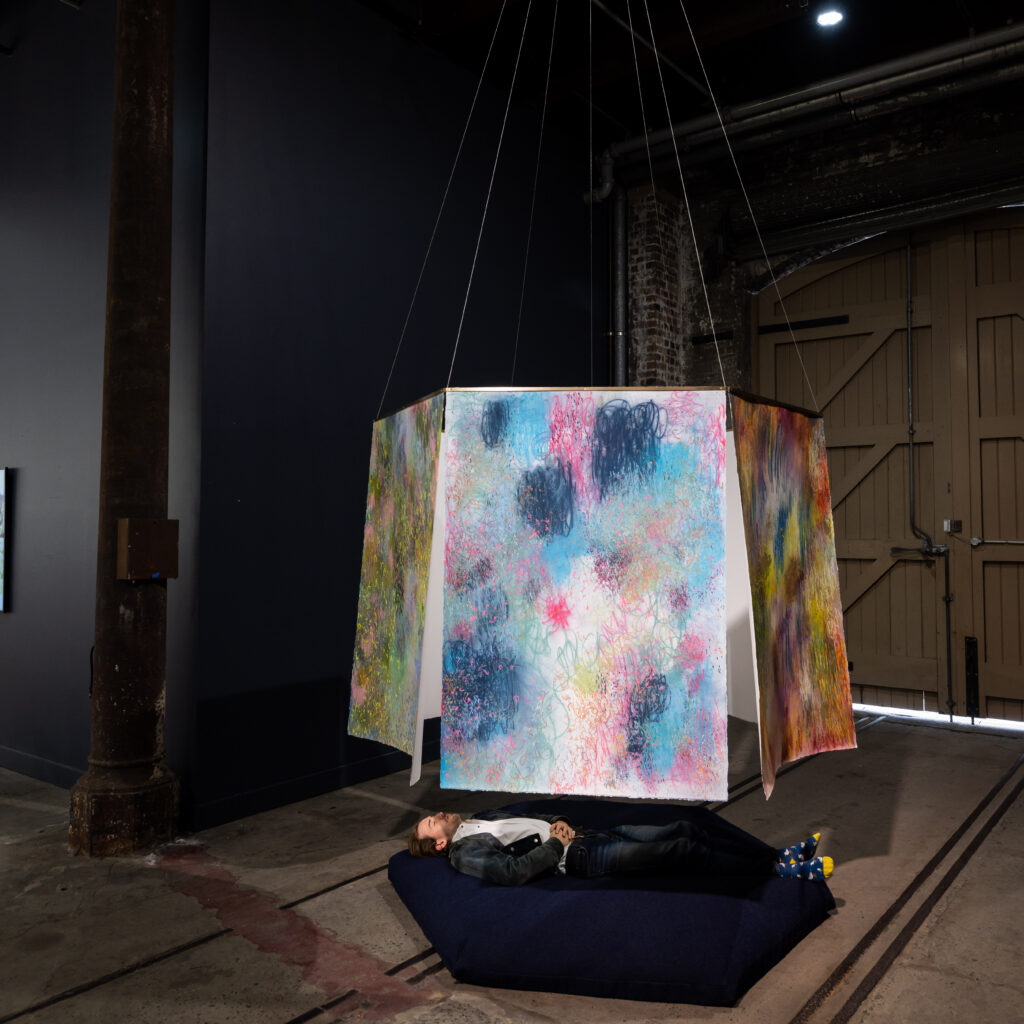
Discharge, 2022
Soft pastel on 640gsm cotton rag (six parts), brass, Herkimer diamond crystal, glass, stainless steel, hexagonal pillow.
152 x 250 x 200 cm
Presented by Laree Payne Gallery
Comprising six Joy Field drawings, Discharge hovers from the ceiling in a hexagonal formation that can be read as a clockwise flow. The synthesis of materials, shape, colour and rhythm aims to activate the inherent energetic qualities of wider perceptual and invisible fields with the intention of generating an energy system at the heart of the work. Comprising six drawings which hang in the form of a hexagon, Discharge bridges Sarah’s drawing practice with her sculptural practice. Rigged from the ceiling and viewed at a traditional hanging height, Discharge generates an intense energy system at its centre. A participatory work, viewers are encouraged to lie beneath the work (on a pillow) to experience the energy system at work, an interesting proposition during an art fair.
Sarah Smuts-Kennedy (b. 1966) completed her MFA at Elam School of Fine Arts at the University of Auckland in 2012. Her practice is focused on a research-based investigation into fields of energy as they engage with conceptual thinking both within art-based languages and other intuition-driven modes of enquiry.
Tony Garifalakis
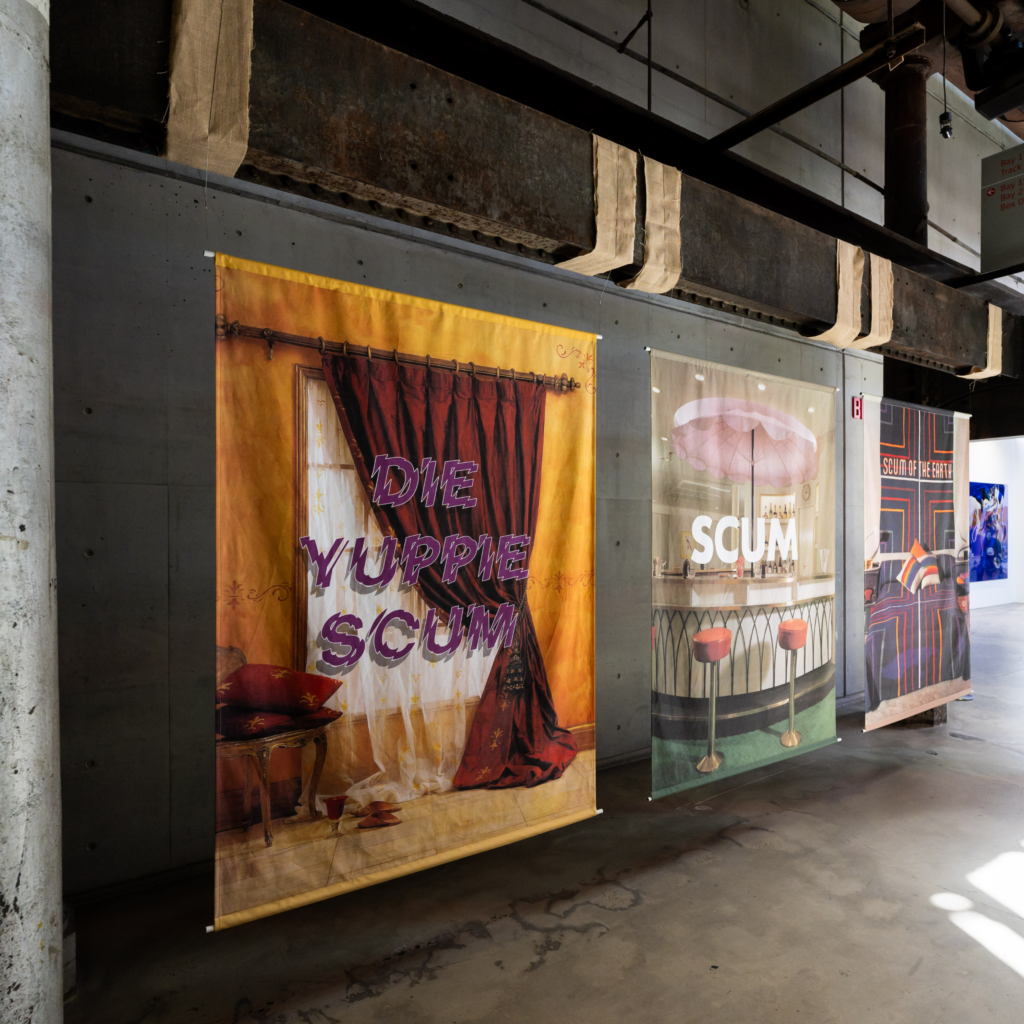
Scum Suite (series), 2017-22
Inkjet print on panama canvas
200 x 145 cm each
Presented by Hugo Michell Gallery
Through his ongoing examination of culturally ascribed forms, Tony Garifalakis knowingly engages image and text – the twin-towers of print design methodology – to shift the semantic register of ‘common’ imagery (pop culture, music, cults, fashion, craft etc) and its components. These signs and symbols present themselves as units of meaning or complicated knots of reference, and are gradually transformed via their dispersal through the frameworks of cultural production. These signs also belong to a discourse between art and design, and they both, as language, are equally destabilised by Garifalakis’ détournement, which challenges the self-mythology so critical to these social structures and the legibility of their announcements – Damiano Bertoli, 2021